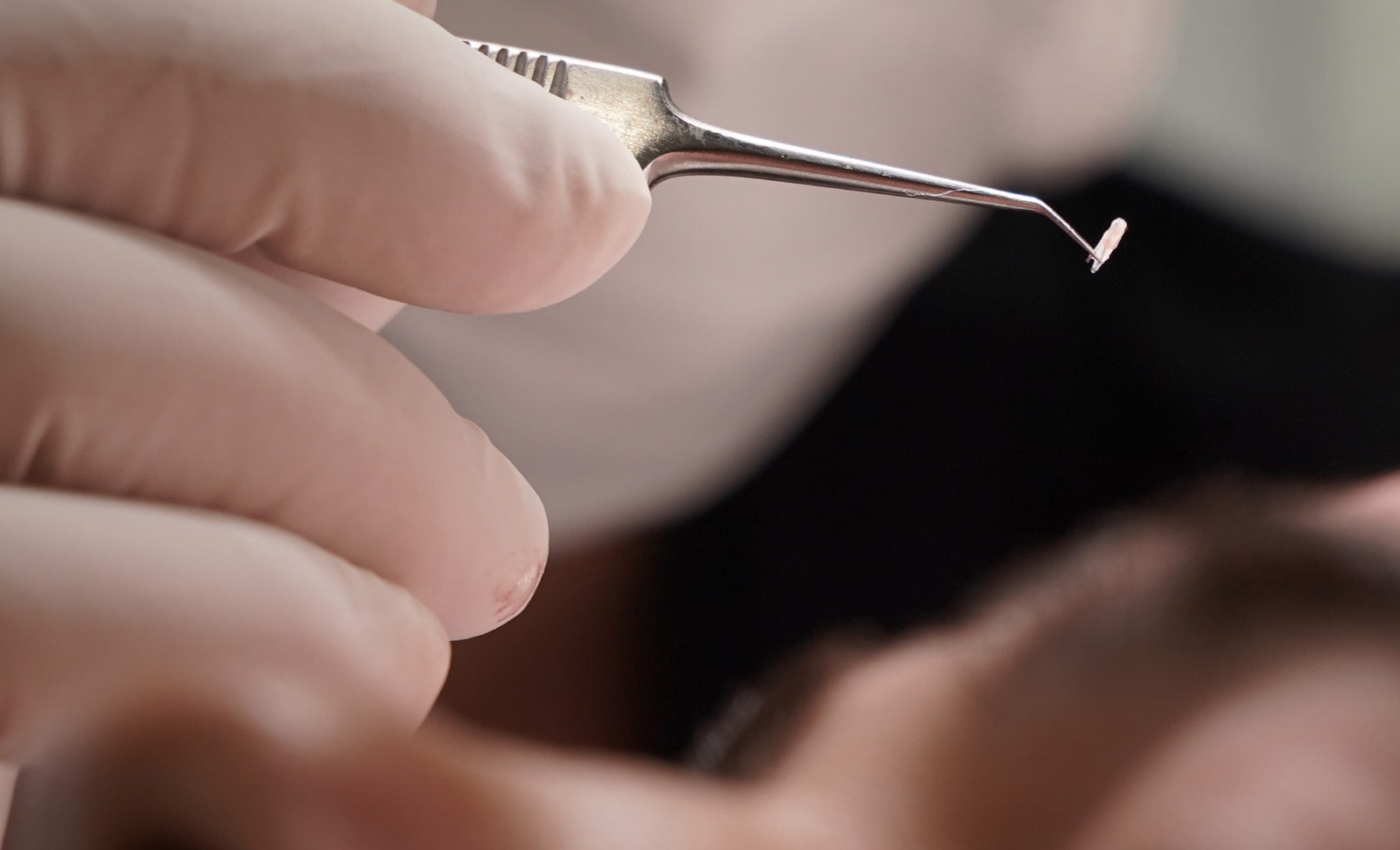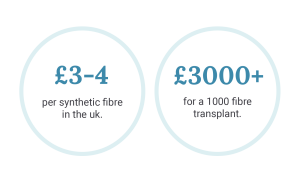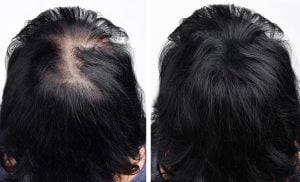Over the years, humans have come up with various methods – some effective, others not so much – to try and reverse hair loss. One of the breakthrough methods in the 20th century was hair transplants, with artificial hair transplants gaining popularity during that time. Even to this day, some people opt for the artificial hair transplant.
Artificial Hair Transplant: What is it?
An artificial hair transplant (also known as a synthetic hair transplant or biofibre hair transplant) is a way for patients to enjoy hair restoration treatment without the need for a donor area. The process involves using synthetic hairs made from polyamide fibres and implanting them into the patient’s scalp. Compared to traditional natural hair transplants, the transplantation goes deeper and provides a faster result.
The Controversies Surrounding Artificial Hair Transplants
The use of fibres in hair transplants was banned in the USA by the Federal Drug Administration in 1983 [1]. The FDA concluded that the process was too risky for patients due to the “nonbiocompatibility” of the synthetic hairs. They concluded that the treatment was a risk to public health and that clinics gave too much misinformation about how effective the treatments were.
There was a lot to back this ban up at the time, with patients undergoing artificial hair transplants in the 70s and 80s often experiencing allergic reactions, infections, and cysts. However, time has moved on since then, and artificial hair transplants do not pose as many risks today as they used to.
Are Artificial Hair Transplants Banned Elsewhere?
While artificial hair transplants have been banned in the United States since 1983, they are still legal in Europe and many other countries. However, there is still some scepticism about how well they work, especially because of the US ban.
How Does an Artificial Hair Transplant Work?
Instead of using a donor area from your head, the surgeon uses synthetic fibres, which come in a wide range of colours, densities, and lengths to suit your needs. Usually, you would choose synthetic fibres that match your original hair. Before beginning the transplant, a surgeon would then do a tolerance test to make sure the synthetic fibre doesn’t negatively interact with your body.
If you pass the tolerance test, then you can go through the artificial hair transplant procedure. It begins with a local anaesthetic to ensure you don’t feel any pain throughout the process. After that, the surgeon then implants individual synthetic fibres into the scalp using a hooked needle. These hairs go quite a bit deeper than a natural hair transplant – about 0.3mm deep.
Who is a Good Candidate for Artificial Hair Transplants?
If you have very little hair on your head because of hair loss, you may be a good candidate for an artificial hair transplant. That’s because you would need a healthy donor area to qualify for this procedure. You should also be in generally good health and usually between the ages of 25 and 70 (but you can speak with your doctor/surgeon if you’re outside of this bracket and think you still might qualify).
What Complications Can Arise from an Artificial Hair Transplant?
There are some artificial hair transplant side effects that you should be aware of before going into the surgery (and your surgeon should also go through them with you). These include:
- Infections
- Allergic Reactions
- Scarring
- Migraines
- Headaches
- A Lot of Future Upkeep
While these complications can arise, it’s also worth mentioning that artificial hair transplants are a lot safer than they used to be. In fact, one study from 2018 [2] showed a successful result from artificial hair transplants in 194 patients. If you find a good surgeon, you will be in safe hands, and complications will be rare.
Artificial Hair Transplant: Aftercare
There’s a lot of aftercare involved in hair transplants. Immediately after the operation is the healing period, which lasts up to four days. During this time, you’ll likely be given a spray for your scalp to use routinely. You’ll also be told to avoid strenuous exercise for at least a few weeks post-operation. Most people take some time off work to allow for this.
Check-ups usually happen after around three months (unless any problems arise), at which point the surgeon will check your scalp and ask you questions about how you’re getting along. You’ll likely have another check-up after a year when healing should be completed, and full results are obvious.
Artificial hair transplants don’t last forever. While they will stay in your head for a long time, the synthetic fibres will fall out eventually, usually after around seven to eight years. When enough has fallen, you’ll need to go back and get more synthetic fibre implants to maintain results.
How Much Does an Artificial Hair Transplant Cost?
The cost of an artificial hair transplant is around £3-4 per synthetic fibre in the UK. If you need 1000 fibres for your transplant, your artificial hair transplant will cost £3,000-£4,000. Of course, everyone is different, and some clinics will cost more than others. It’s always best to prioritise choosing an excellent clinic with a good track record rather than cost.
Should You Get an Artificial Hair Transplant?
It’s a decision you can only make after speaking to a qualified hair transplant surgeon. You need to know all the risks involved, as well as expectations about the results. If you have a lot of hair loss to the point where you wouldn’t be able to get a natural hair transplant, it’s certainly an option to explore.
What Are the Pros and Cons of an Artificial Hair Transplant?
Is getting an artificial hair transplant worth it? It’s an enormous decision to make, so it’s important to weigh up the pros and cons first – especially if you’re also considering other hair restoration options.
The Pros of an Artificial Hair Transplant
- Fast Results
Artificial hair transplants give quick results; you can enjoy a full head of hair almost instantly.
- You Don’t Need Hair
You don’t need a healthy donor area for an artificial hair transplant, which is what makes them so popular with people who have extreme hair loss.
The Cons of an Artificial Hair Transplant
- Not Your Natural Hair
Everyone has unique hair density, colour, and shape –artificial hair will never be able to replicate that. It can get close, though.
- A Lot of Aftercare
You can’t just get an artificial hair transplant and forget about it. As well as post-op care, they require ongoing upkeep throughout your life as the synthetic hairs will slowly fall out. This will also mean paying money continuously throughout your life.
- You Can’t Cut or Dye it
Dyeing your artificial hair is a no-go. While you can cut it, it won’t grow back like regular hair. For some people, this lack of control doesn’t matter, as they are happy to have a full head of hair again.
What About Natural Hair Transplants?
There are two types of natural hair transplants: FUT (Follicular Unit Transplantation) and FUE (Follicular Unit Extraction). At HS Hair Clinic, we perform the FUE method, which involves extracting individual hair follicles for a more natural look. This hair restoration surgery takes around twelve months to see full results, but it is worth it for many people, thanks to how natural they look once the hair grows through.
Are You a Candidate for a Natural Hair Transplant?
If your hair loss is only in some areas, you might be a good candidate for a hair transplant. You’ll need a donor area that involves healthy hair, which the surgeon can extract from. Also – much like with transplants using artificial hair – you should also be in overall good health and between 25 and 70 years old.
Artificial vs Real Hair Transplants: The Key Differences
- Artificial hair transplantation provide immediate results, while natural hair transplants take around twelve months to see full results.
- Natural hair transplants use the patient’s own hair follicles; artificial transplants use synthetic fibres.
- Artificial hair transplants require a tolerance test and more aftercare.
- Natural hair transplants are permanent, while the synthetic hairs will fall over time.
Other Kinds of Hair Transplants
Here at Harley Street Hair Clinic, we offer a range of highly effective and safe hair transplants given by only the best surgeons. Some of our procedures include FUE hair transplants, FUE eyebrow reconstruction, hair scar repair, and transgender hair transplants. If you have any questions or you want to begin your hair restoration journey, download our app or book a consultation. Our app allows you to track your hair growth while gaining access to consultations with our hair transplant surgeons.
In Summary
An artificial hair transplant is an option in certain countries, including the UK. While there have been some controversies surrounding its effectiveness and risks in the past, it is a safe procedure today, with many people experiencing fabulous results. For people who don’t have any hair at all, it’s a solution that helps restore their confidence.
Sources:






